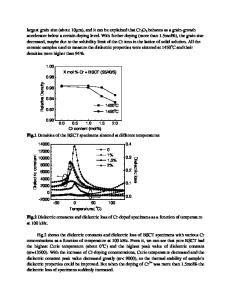Microwave Dielectric Properties of LaScO 3 -TiO 2 Materials
- PDF / 1,045,044 Bytes
- 6 Pages / 612 x 792 pts (letter) Page_size
- 83 Downloads / 432 Views
B5.14.1
Microwave Dielectric Properties of LaScO3-TiO2 Materials Do-Kyun Kwon, Michael T. Lanagan, and Thomas R. Shrout Materials Research Institute, The Pennsylvania State University, University Park, PA.16802, U.S.A ABSTRACT From fundamental ionic polarizability concepts, LaScO3 was projected as a candidate dielectric material for microwave application. The microwave dielectric properties of LaScO3 were obtained as the dielectric permittivity of 24, Q×f of 18,000 GHz, with a temperature coefficient of resonant frequency (TCF) of -69 ppm/oC. Solid solutions and polyphase assemblages were investigated in the LaScO3-TiO2 system as a function of TiO2 content, and correlated with the microwave dielectric properties. Orthorhombic perovskite LaScO3 transformed to tetragonal symmetry with Ti substitution on the B-site of LaScO3 owing to the ionic radius difference between Sc3+ and Ti4+. With this phase transition, the formation of A-site vacancies (VLa″′) resulted in the precipitation of a La deficient secondary phase. The substitution of Ti also affected the dielectric properties. The dielectric constant increased and TCF became less negative with increased TiO2 addition. However, the Q×f value decreased, due to the formation of the secondary phase. For the case of the 0.6LaScO3-0.4TiO2 composition, a dielectric K of 40, Q×f of 6,000 GHz and nearly zero TCF were obtained. INTRODUCTION Considerable groups of dielectric materials for microwave applications are based on solid solutions with the perovskite structure. Several La-based perovskites have been investigated as microwave dielectric materials because of their high quality factor (Q) and high dielectric permittivity (εr) owing to the high dielectric polarizability of the La3+ ion [1-3]. For example, LaAlO3 exhibits a relative permittivity of 24, a Q×f > 65000, and a temperature coefficient of resonant frequency (TCF) = -44 ppm/oC, which makes it an ideal condition as a substrate for high-Tc superconductor thin films [3]. For the application of dielectric resonators, the (1x)LaAlO3-xTiO2 solid solution system was explored to modify the negative temperature coefficient of resonance frequency (TCF) of LaAlO3 [4]. (1-x)LaAlO3-xTiO2 solid solution system showed nonmonotonic mixture-like behavior in dielectric properties as a function of composition in the range of x < 0.6. A similar phenomenon revealed in the LaAlO3-SrTiO3 solid solution system [5]. The mixture-like behavior is characterized as the suppressed rate of increase of permittivity and TCF with the composition change that results from the dielectric properties of LaAlO3 which structurally dominates the properties of the solid solution. Based on the Clausius-Mossotti relationship and ionic polarizability calculations by Shannon [6], LaScO3 perovskite material is also expected to be an excellent dielectric compound for microwave applications under the concept of high polarizabilities and ionic masses of cations. In this paper, a new dielectric compound of the (1-x)LaScO3-xTiO2 solid solution system was explored.
Data Loading...











